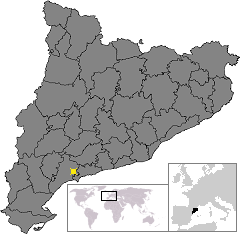Reus
| Reus | |||
|---|---|---|---|
| Municipality | |||

Monument to Joan Prim
|
|||
|
|||
 Location of Reus in Catalonia |
|||
| Location in Catalonia | |||
| Coordinates: 41°09′22″N 1°06′29″E / 41.156°N 1.108°ECoordinates: 41°09′22″N 1°06′29″E / 41.156°N 1.108°E | |||
| Country |
|
||
| Community |
|
||
| Province | Tarragona | ||
| Comarca | Baix Camp | ||
| Government | |||
| • Mayor | Carles Pellicer Punyed (2015) (CiU) | ||
| Area | |||
| • Total | 52.8 km2 (20.4 sq mi) | ||
| Elevation | 134 m (440 ft) | ||
| Population (2014) | |||
| • Total | 104,962 | ||
| • Density | 2,000/km2 (5,100/sq mi) | ||
| Demonym(s) | Reusenc | ||
| Website | www |
||
Reus (Catalan pronunciation: [ˈrɛws]) is the capital of Baix Camp, in the province of Tarragona, in Catalonia, Spain. The area has always been an important producer of wines and spirits, and gained continental importance at the time of the Phylloxera plague. Nowadays it is known by its commercial activity, for being a centre for rock-climbing and as the birthplace of architect Antoni Gaudí.
The origin of the name is a source of discussion. One of the theories is that Reus comes from the Latin word used to describe convict prisoners (reus), and as such, it would be a Roman penitentiary. Currently, the most accepted theory is that the name has Celtic roots, from the root red that originated the name redis (or reddis), that would approximately mean place in the way / place in the roads, or said alternatively, an inhabited place in a cross-road.
Around 1150 Robert d'Aguiló repopulated the region of Reus, after receiving it on 3 June 1154. On 5 June 1154 the archbishop of Tarragona gave two-thirds of Reus to Bertran de Castellet, as a castellan, with the order to build a church. On 29 June 1159, the distribution of income from ecclesiastical goods, the third of its Reus parish of Santa Maria was awarded to the camerlengo, starting the duplicity of governing the town. The camerlengo has the third of Reus parish. At this time the city was known as Redis or Reddis. The castellan Bernat de Bell-lloc gave the title of town to Reus on 3 August 1183, giving the ownership of houses and gardens, establishing a census to pay for farmland and reserving justice, but recognizing its vassalage towards the archbishopric of Tarragona. On 2 June 1186 the camerlengo Joan de Santboi confirmed the rights given by the castellan Bernard de Bell-lloc.
...
Wikipedia



